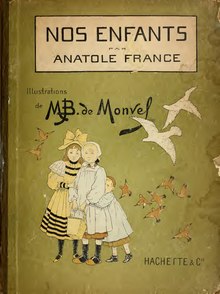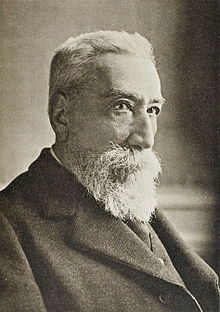
Anatole France (born Franois-Anatole Thibault, ; 16 April 1844 – 12 October 1924) was a French poet, journalist, and successful novelist with several best-sellers. Ironic and skeptical, he was considered in his day the ideal French man of letters. He was a member of the Acadmie franaise
, and won the 1921 Nobel Prize in Literature “in recognition of his brilliant literary achievements, characterized as they are by a nobility of style, a profound human sympathy, grace, and a true Gallic temperament”. France is also widely believed to be the model for narrator Marcel’s literary idol Bergotte in Marcel Proust‘s In Search of Lost Time.
The son of a bookseller, France spent most of his life around books and was a bibliophile. His father’s bookstore, called the Librairie France, specialized in books and papers on the French Revolution and was frequented by many notable writers and scholars of the day. France studied at the Collge Stanislas, a private Catholic school, and after graduation he helped his father by working in his bookstore. After several years he secured the position of cataloguer at Bacheline-Deflorenne and at Lemerre. In 1876 he was appointed librarian for the French Senate.
Anatole France began his literary career as a poet and a journalist. In 1869, Le Parnasse Contemporain published one of his poems, “La Part de Madeleine“. In 1875, he sat on the committee which was in charge of the third Parnasse Contemporain compilation. As a journalist, from 1867, he wrote many articles and notices. He became famous with the novel Le Crime de Sylvestre Bonnard (1881). Its protagonist, skeptical old scholar Sylvester Bonnard, embodied France’s own personality. The novel was praised for its elegant prose and won him a prize from the Acadmie franaise. In La Rotisserie de la Reine Pedauque (1893) Anatole France ridiculed belief in the occult; and in Les Opinions de Jrme Coignard (1893), France captured the atmosphere of the fin de sicle. France was elected to the Acadmie franaise in 1896. Anatole France took an important part in the Dreyfus affair. He signed mile Zola‘s manifesto supporting Alfred Dreyfus, a Jewish army officer who had been falsely convicted of espionage. France wrote about the affair in his 1901 novel Monsieur Bergeret. France’s later works include L’le des Pingouins (Penguin Island, 1908) which satirizes human nature by depicting the transformation of penguins into humans – after the animals have been baptized by mistake by the nearsighted Abbot Mael. It is a satirical history of France, starting in Medieval times, going on to the writer’s own time with special attention to the Dreyfus Affair and concluding with a dystopian future. Les dieux ont soif (The Gods Are Athirst, 1912) is a novel, set in Paris during the French Revolution, about a true-believing follower of Maximilien Robespierre and his contribution to the bloody events of the Reign of Terror of 1793-94. It is a wake-up call against political and ideological fanaticism and explores various other philosophical approaches to the events of the time. La Revolte des Anges (Revolt of the Angels, 1914) is often considered Anatole France’s most profound novel. Loosely based on the Christian understanding of the War in Heaven, it tells the story of Arcade, the guardian angel of Maurice d’Esparvieu. Arcade falls in love, joins the revolutionary movement of angels, and towards the end realizes that the overthrow of God is meaningless unless “in ourselves and in ourselves alone we attack and destroy Ialdabaoth.” He was awarded the Nobel Prize in 1921. He died in 1924 and is buried in the Neuilly-sur-Seine community cemetery near Paris. On 31 May 1922, France’s entire works were put on the Index Librorum Prohibitorum (Prohibited Books Index) of the Catholic Church. He regarded this as a “distinction”. This Index was abolished in 1966.
In 1877, Anatole France married Valrie Gurin de Sauville, a granddaughter of Jean-Urbain Gurin a miniaturist who painted Louis XVI, with whom he had a daughter, Suzanne, in 1881 (dec. 1918). France’s relations with women were always turbulent, and in 1888 he began a relationship with Madame Arman de Caillavet, who conducted a celebrated literary salon of the Third Republic; the affair lasted until shortly before her death in 1910. After his divorce in 1893, he had many liaisons, notably with Mme Gagey, who committed suicide in 1911. France married again in 1920, Emma Laprvotte. Politically, Anatole France was a socialist and an outspoken supporter of the 1917 Russian Revolution. In 1920, he gave his support to the newly founded French Communist Party. France was also an atheist.
After his death in 1924 France was the object of written attacks, including a particularly venomous one from the Nazi collaborator Pierre Drieu La Rochelle, and detractors decided he was a vulgar and derivative writer. An admirer, the English writer George Orwell, defended him however and declared that he remained very readable, and that “it is unquestionable that he was attacked partly from political motive.” Anatole France was also documented to have a brain size just three-quarters the average weight, and racial anthropologist Arthur Keith argued that this correlated well with the fact that his life had demonstrated that he was in many ways “a primitive man”.
France caricatured by Jean Baptiste Guth for Vanity Fair, 1909 Nos Enfants, illustrations by Louis-Maurice Boutet de Monvel (1900)Overview
Early Years
Literary Career
Private Life
Reputation
Works
Poetry
Prose fiction
Memoirs
Plays
Historical biography
Literary criticism
Social criticism



